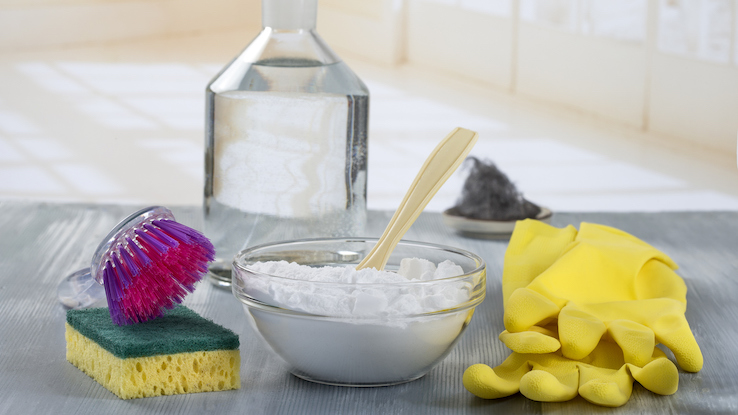How to Unclog an Easy Off Oven Cleaner Aerosol Can

Using baking soda and vinegar to unclog drain pipes is an age-old hack. But does it really work? And is baking soda and vinegar safe for drains?
As long as you follow some simple instructions and precautions, it is indeed possible to use this method to safely clear up minor drain clogs. Join us for a closer look at this approach, how to do it, and a couple of safety precautions to keep in mind.
If you ever made a volcano for a school science project, then you're already familiar with the reaction baking soda and vinegar produce when their forces combine. But why do they go so crazy when they meet? Well, baking soda is a base and vinegar is an acid, so when the two meet, they neutralize each other.
This reaction creates water and carbon dioxide bubbles, which rapidly expand. The expanding bubbles create pressure, similar to what happens when you shake up a carbonated soda can. All that pressure gets released down your drain and helps loosen the clog and push it on through. In the method we'll explain below, you'll also add boiling water and grease-fighting dishwashing detergent to help loosen any grease or other residue that may be lurking in your pipes.
Remember that we are indeed about to clean your drain by using a chemical reaction, so it's important to make sure you avoid any unintended reactions with other cleaning products. Don't use this method either right before or right after using a different type of chemical drain cleaner due to the possibility that your accidental science experiment could result in harmful fumes or vapors.
If you do want to try using baking soda and vinegar on your drain, make sure that any other chemicals have been thoroughly washed away first.
When to Use Baking Soda and Vinegar
If you're looking for a cheap way to clean smelly sinks or clear out minor clogs, then baking soda and vinegar may be the solution for you. However, it's important to note that if you're dealing with a major drain blockage, it's best to call your plumber, as this mixture is probably not strong enough to clear more serious clogs.
When it comes to kitchen sinks, baking soda and vinegar can help clean your pipes by clearing out build-ups caused by oil, grease and fat. The other perk is that in the course of the process, the mild disinfectant properties of the baking soda can help sweep away bacteria, fungi and other things that can cause nasty odors.
As far as bathroom drains go, vinegar and baking soda can work well for helping clear out debris caused by soap scum, toothpaste and hair. While some clogs are tougher than others, it never hurts to give this home remedy a shot before resorting to harsh chemicals or disassembling your pipes.
Even if you aren't dealing with an uncooperative drain, using this method as a regular maintenance cleaning routine can help prevent pipes from clogging up in the first place.
How to Use Vinegar and Baking Soda to Clean Drains
Before you begin, assemble the following items:
- A pot or kettle
- Grease-fighting dishwashing liquid
- Distilled white vinegar
- Baking soda
- A measuring cup
Step 1: Boiling Water and Dish Soap
Start by heating at least two cups of water in the pot or kettle. When the water comes to a boil, squeeze a bit of the dishwashing liquid into the sink and carefully follow it up with the boiling water. The hot water can help make the process easier by loosening or dissolving the residue in your drain, while the dishwashing liquid helps tackle any grease.
Step 2: Baking Soda and Vinegar
Next, use the measuring cup to measure out one cup of baking soda. You want to get it as far down the drain as possible, which may not always be easier if you're dealing with a bathroom sink or smaller pipe. If this turns out to be the case, then try enlisting the help of a funnel. Place the funnel's narrow end into the drain and slowly pour the baking soda in through the top.
Now it's time to measure out one cup of white vinegar. Brace yourself because when you pour it into the drain, the magic will start to begin. When it makes contact with the baking soda, the two will start to interact and fizz, grade school science-class style. At this point, some people recommend plugging the drain opening with a cloth, which in effect makes sure that the same volcano-like reaction happens inside the pipe rather than escaping through the top of the drain.
Step 3: More Boiling Water
Now it's time to give your homemade reaction a little time to do its thing. Let it sit for at least 10 minutes after the first fizzing action begins. While you wait, head back over to the stove and use your pot or kettle to heat up a few more cups of boiling water.
After 10 minutes or so, pour the boiling water into the drain to make sure everything moves on through. If your sink seems to be flowing freely at this point, you can go ahead and turn on the hot water to make sure any traces of the mixture are thoroughly washed out of the pipe. If your drainage still seems a little slow, however, you can try repeating the same steps one more time.
We hope this has helped answer your questions about unclogging drains with this old-school plumbing hack!
desailllymindighisent.blogspot.com
Source: https://www.symptomfind.com/healthy-living/the-best-drain-cleaner-to-unclog-a-basement-drain?utm_content=params%3Ao%3D740013%26ad%3DdirN%26qo%3DserpIndex&ueid=3eea7f73-e87f-4f8d-912d-b2bca48c4133